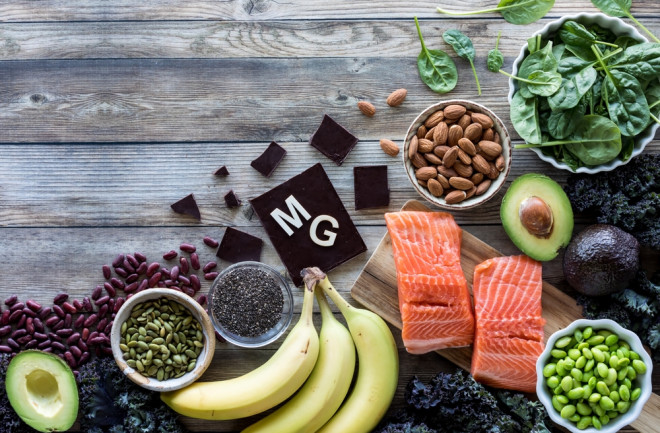Minerals accomplish all kinds of tasks to keep our bodies running, and one in particular — magnesium — has its own functions that make it a necessary component of human health. This mineral activates over 300 enzymes that help the body build proteins, strengthen bones, support nerve and muscle function, and regulate heart rhythm.
As with other essential minerals, the key to maintaining a proper magnesium level is through the foods we eat. A diet that lacks magnesium can spell a number of problems for the body; magnesium deficiency (hypomagnesemia) may bring on weak bones, muscle cramps, sleeplessness, and more severe cases may even lead to high blood pressure and heart disease.
One 2018 study states that “approximately half of the U.S. population consumes less than the required amount of magnesium” because of dietary habits, the removal of minerals in processed food, and decreasing mineral richness in soil over the years.
For context, the Recommended Dietary Allowance for most male adults is 400-420 mg daily, and for most female adults, 310-320 mg daily. If this statistic has you anxiously wondering if your magnesium intake is enough, don’t fret. Shaping a diet that gives you a healthy amount of magnesium is easy with the right foods.
What Foods Are High in Magnesium?
To boost magnesium levels, there are a variety of magnesium-packed foods. Nuts, greens, and legumes are just a few, and there are plenty of other foods that have magnesium levels. Here is a breakdown of how much magnesium levels these foods provide.
Nuts and Seeds
Snacking on nuts and seeds is a surefire way to raise your magnesium intake. A few solid choices of nuts include almonds (1 oz= 77 mg) and cashews (1 oz= 83 mg), and the best seeds include hemp seeds (3 tbsp= 210 mg), chia seeds (1 oz=111 mg), and hulled, roasted pumpkin seeds (1 oz= 150 mg).
Nuts and seeds tend to be great options for protein and healthy fats as well, but be careful about eating too many because they are especially calorie-dense.
Greens
With such a renowned reputation in nutrition, it’s no surprise that leafy greens are some of the most reliable sources of magnesium. Standout examples of greens packed with the mineral include Spinach and Swiss Chard.
If you want to get the most magnesium out of these greens, make sure to blanch, boil, or steam them. Doing so reduces oxalic acid, a compound that can inhibit the absorption of minerals. Leafy greens are often high in oxalic acid, but using the aforementioned cooking methods will result in a much higher magnesium level.
For example, 1 cup of raw spinach contains 24 mg of magnesium, while 1 cup of cooked contains 157 mg. 1 cup of raw Swiss chard has 29 mg of magnesium, while 1 cup of cooked contains 150 mg.
Fruits
Certain fruits will help contribute to your magnesium intake. Often referenced as a go-to for potassium, bananas should be recognized for their magnesium content as well (1 large banana = 37 mg).
Avocados have arguably become one of the most popular foods in recent years, touted for their healthy fats. It turns out magnesium also plays a role, albeit somewhat unsung, in the fruit’s nutritional greatness (1 whole avocado = 58 mg).
Even though they haven’t caught on as much as avocados, figs have a high mineral content compared to other fruits. If you’re searching for magnesium in particular, consider picking up dried figs (1 cup = 101 mg), which have a higher amount of the mineral than fresh figs. Keep in mind that dried figs also have more calories and sugar than fresh ones.
Legumes
These plants, whose seeds are often called beans, provide a considerable portion of magnesium in diets. Varieties that will increase intake of the mineral include lima beans (1 cup cooked = 126 mg) and black beans (1 cup cooked = 120 mg).
Peanuts are also a good option for magnesium (1 oz = 48 mg), and peanut butter is another tasty way to get the mineral (2 tablespoons = approx 50 mg).
Whole Grains
Whole grains are extremely beneficial for diets, with high magnesium being just one perk. Some of the best options are amaranth (1 cup cooked = 160 mg), teff (1 cup cooked =126 mg), and quinoa (1 cup cooked = 118 mg). Can’t find these foods at the grocery store? Brown rice also works nearly as well (1 cup cooked = 84 mg).
Seafood
Eating plant-based foods is the best way to increase your magnesium intake, but certain animal-based foods — particularly seafood — can also help. Fatty fish like salmon (0.5 fillet = 53 mg) and mackerel (1 fillet = 85 mg) are good sources of magnesium and other nutrients. If you’re feeling adventurous, canned oysters (1 cup, drained = 96 mg) will definitely fulfill your magnesium needs.
Dark Chocolate
It may comfort you to know that you can indulge while fitting more magnesium into your diet. Dark chocolate (1 oz of 70-85 percent cocoa = 64 mg) packs a surprisingly nutritious punch, but don’t expect to experience the signature sweetness found in milk chocolate. Also watch out for calories, fat, and added sugar.
There are other ways to get magnesium, such as mineral water and supplements, but it’s recommended to stick to these foods.
Read More: What You Should Know About Magnesium Supplements
This article is not offering medical advice and should be used for informational purposes only.
Article Sources
Our writers at Discovermagazine.com use peer-reviewed studies and high-quality sources for our articles, and our editors review for scientific accuracy and editorial standards. Review the sources used below for this article:
Harvard School of Public Health. The Nutrition Source
The Clinical biochemist. Magnesium Metabolism and its Disorders
Nutrients. Magnesium: Are We Consuming Enough?
National Institutes of Health: Office of Dietary Supplements. Magnesium. Fact Sheet for Consumers
Washington College. Reducing Oxalates

